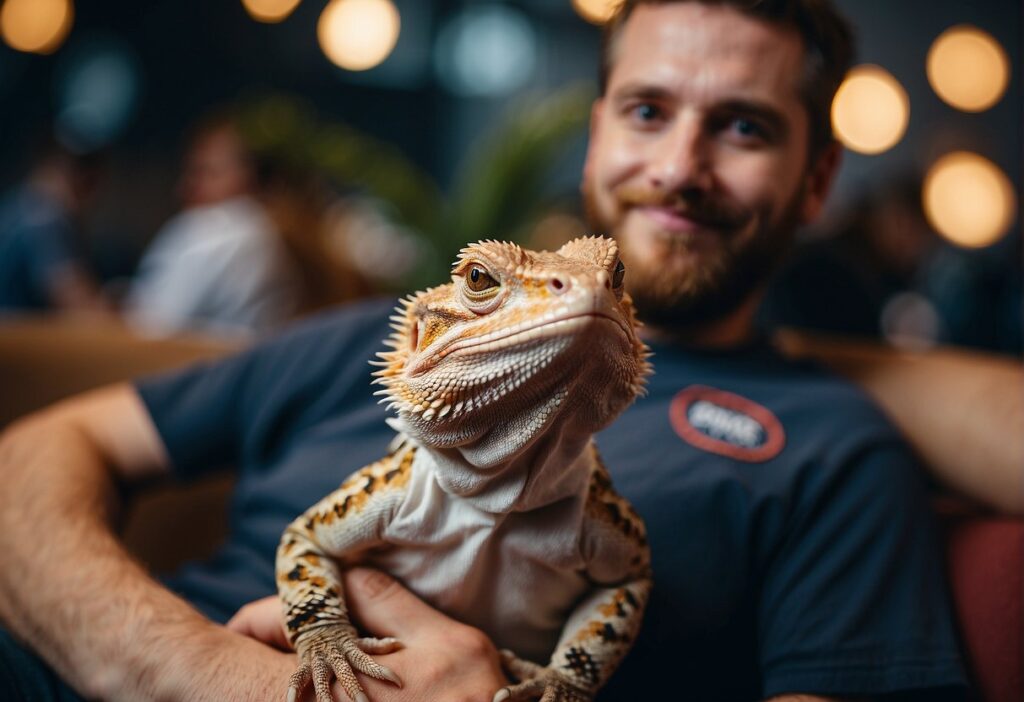In recent years, emotional support animals (ESAs) have gained recognition for their role in assisting individuals with mental health challenges, such as anxiety and depression. Unlike service animals, ESAs do not require specific training to perform tasks, as their primary role is to offer comfort and support through their presence. While dogs and cats are commonly thought of as ESAs, a variety of animals can serve in this capacity, including less traditional ones like bearded dragons.
Bearded dragons are becoming a more popular choice for an ESA due to their manageable size and generally docile nature. These reptiles can provide companionship without the need for the extensive space and care that larger animals require. Plus, for those living in confined spaces or having allergic reactions to furry pets, bearded dragons can be an excellent alternative. You can register your bearded dragon as an ESA with a recommendation from a mental health professional, acknowledging the support the animal provides for your emotional well-being.
Bearded Dragons as ESAs

Bearded dragons are becoming increasingly recognized for their potential as emotional support animals (ESAs). They offer comfort and companionship with a unique set of characteristics.
Characteristics of Bearded Dragons
Bearded dragons are known for their relaxed demeanor, which makes them suitable companions if you’re seeking a sense of calm. Typically, they have a lifespan of 10-15 years, ensuring long-term companionship. They’re low-maintenance compared to other pets, requiring less daily care and attention, which might align with your lifestyle if you’re not keen on or capable of high-energy animals.
Benefits of a Bearded Dragon ESA
One of the main benefits of a bearded dragon as an ESA is its ability to provide comfort with its calm presence. Moreover, caring for a bearded dragon can also give you a sense of purpose. Unlike many mammals, reptiles such as bearded dragons can be handled without causing them stress, provided they have been properly socialized. They add diversity to the types of animals typically considered as ESAs, and their low-stress needs could mesh better with individuals who require a more manageable pet care routine.
Drawbacks and Considerations
When considering a bearded dragon as an ESA, it’s crucial to be aware of their specific needs, such as the requirement for a controlled environment with heat and UV lighting. While they are low maintenance, they do have some specific habitat and dietary needs that are pivotal for their wellbeing. Additionally, not everyone may be comfortable with a reptile as a companion, so consider your own preferences and that of those around you.
Living with Your Bearded Dragon ESA

Bearded dragons are recognized as emotional support animals (ESAs), and living with one involves understanding their unique needs in various settings, including home, during travel, and in public spaces. They can impact your daily routines positively and provide comfort through consistent interaction.
Traveling and Public Access
When you’re traveling with your bearded dragon ESA, you’ll need a recommendation letter from a medical professional stating the necessity of your ESA for emotional support. This letter typically must be on the professional’s letterhead. While not all public places, like restaurants, are required to accommodate ESAs, this documentation can aid in gaining access where possible. Remember that airlines have specific policies for ESAs, and you should check these before making travel plans.
- Letter Requirements:
- On professional’s letterhead
- Signed by a licensed doctor or therapist
- States the need for your ESA
Daily Routine and Interaction
Incorporating your bearded dragon into your daily routine can provide structure for both you and your pet. Your bearded dragon will require daily feeding, a consistent temperature environment, and time out of their enclosure to explore and interact. These pets can be great conversation starters and provide social interaction in day-to-day life.
Training and Behavior
Bearded dragons may not require traditional training like dogs, but they can be taught basic behaviors such as handling and socialization. Training your bearded dragon involves gentle and consistent handling to get them accustomed to you and avoid stress in different environments. As they are naturally docile, bearded dragons are typically easy to manage with proper handling; however, they can become stressed in loud or chaotic environments.
Specific Concerns and FAQs

When you’re considering a bearded dragon as an emotional support animal (ESA), you might have specific concerns such as allergies or space requirements. It’s a good idea to compare how they stack up against other ESAs when making your choice.
Allergies and Living Spaces
If you’re worried about allergies or have a smaller living space, bearded dragons might be an ideal ESA option. Unlike cats or dogs, they are less likely to trigger allergic reactions since they don’t have fur or feathers that can carry allergens. Their compact size also means they can comfortably live in smaller spaces, provided you have a suitable tank for them. However, regular tank cleaning is essential to maintain a healthy environment for both you and your dragon.
Comparing ESAs: Bearded Dragons vs Other Animals
When considering different ESAs, there’s a lot to think about. Here’s a quick comparison:
- Cats and Dogs: They’re known for their companionship but may not be suitable for those with allergies or limited space.
- Horses, Pigs, and Peacocks: These animals can offer support but typically need ample space and specific environments.
- Bearded Dragons: They are known for their calm demeanor and require less space than many traditional ESAs. However, they do need specific heating and lighting setups to thrive.
Remember that any ESA, including bearded dragons, should not cause a problem for other people or animals in public settings.
Emotional and Social Benefits of Having a Bearded Dragon ESA

Bearded dragons are making their way into the hearts of many as unconventional yet effective emotional support animals (ESAs). Their calming presence and potential to provide companionship cater to various emotional and social needs, reducing feelings of loneliness and anxiety.
Emotional Comfort and Therapy
Companionship: A bearded dragon can bring you a sense of companionship, helping to alleviate feelings of loneliness. Their constant presence can be a source of comfort and a therapeutic experience, providing a calming influence during stressful times.
Therapeutic Presence: Interacting with your bearded dragon can serve as a form of emotional support. The routines of feeding, handling, and caring for your pet can offer you a sense of purpose and satisfaction, further fostering a therapeutic bond.
Social Benefits and Interactions
Conversation Starters: Owning a bearded dragon can also boost your social interactions. They’re unique pets that can easily become a talking point, serving as ice breakers and helping you connect with others over shared interests.
Confidence and Pride: Caring for a bearded dragon may increase your confidence and give you a feeling of pride. Sharing your experiences and knowledge about your ESA can lead to increased social engagement and help ease social anxiety, as your bearded dragon becomes a familiar friend in unknown social situations.
Advantages of Bearded Dragons Over Other ESAs

Bearded dragons offer specific benefits that make them standout choices for emotional support animals, especially if you’re considering a pet that is low-maintenance and better suited for smaller living spaces.
Temperament and Behavior
Your bearded dragon is likely to be well-behaved and boasts a calm and relaxed demeanor. These reptiles are known for being quiet and docile, which makes them superb companions if you’re looking for a pet that won’t disrupt your daily life with noise. Bearded dragons tend to enjoy human interaction, often seeking out warm places to lounge, which might include your lap, giving you company without demanding constant attention.
Space and Care Requirements
Bearded dragons require significantly less space than many traditional pets. They can thrive in a terrarium suited to their size, making them particularly suitable for apartment living or small homes. In terms of care, they are low-maintenance pets; their diet consists of live food, like crickets and worms, as well as veggies, giving you a manageable routine. While they do need a warm environment and specific lighting, once these fixtures are in place, the day-to-day upkeep is minimal.
Uniqueness and Diversity
Having a bearded dragon as an ESA certainly adds a unique element to your life. Unlike commonly chosen ESAs such as dogs or cats, bearded dragons provide an exotic flair and can be a conversation starter. They also come in a variety of colors and patterns, adding an aesthetic diversity to your choice of pet. Emotionally, the distinct presence of a bearded dragon can offer a different kind of comfort that stands apart from other animals due to their serene disposition and unique appearance.











